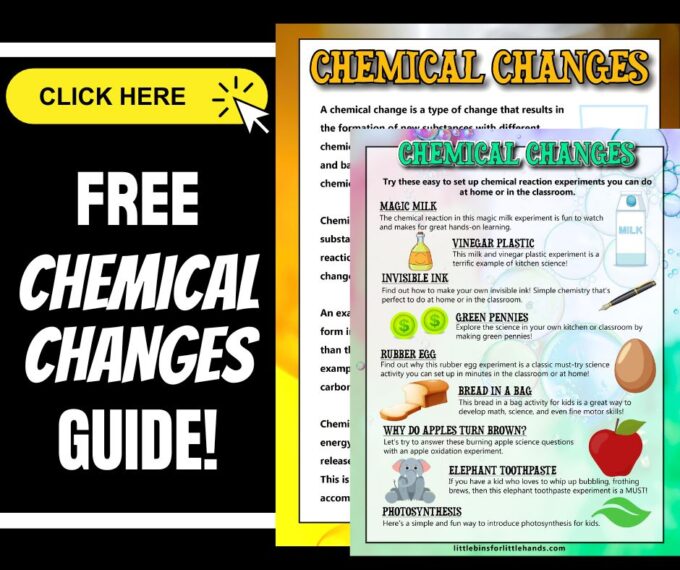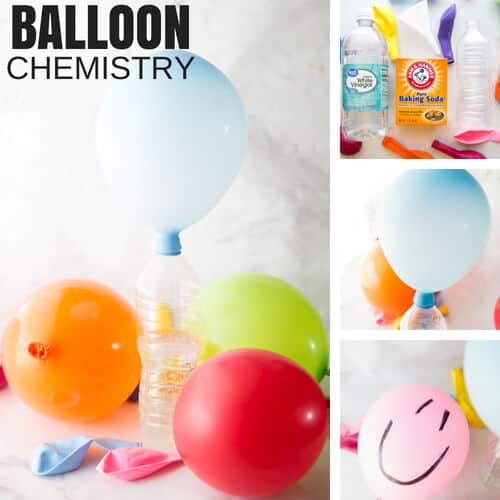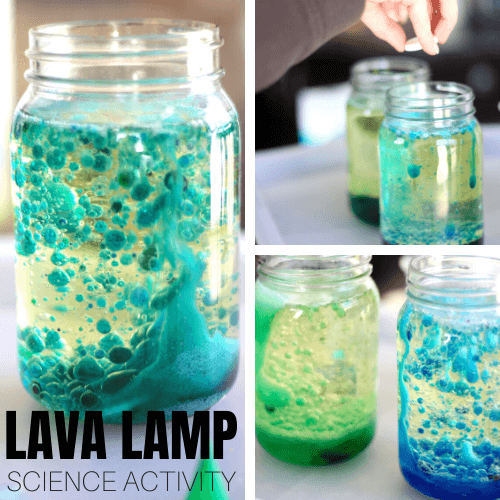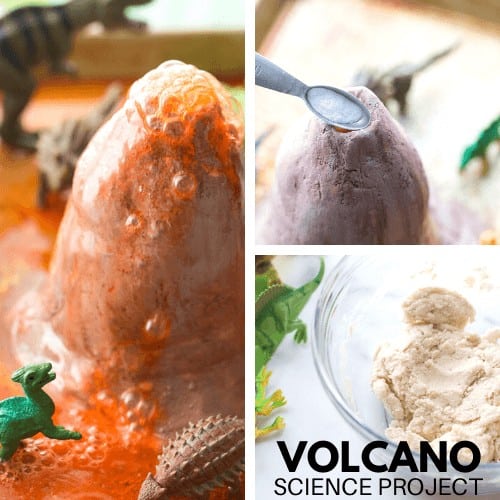What is a chemical change? Learn how to identify a chemical change vs. a physical change with a simple definition of chemical change and everyday examples. Explore chemical changes with easy, hands-on science experiments kids will love. Fizzing chemical reactions, bread in a bag you can eat, homemade bath bombs, Elephant’s Toothpaste, and more. Fun science project ideas for all ages of kids!
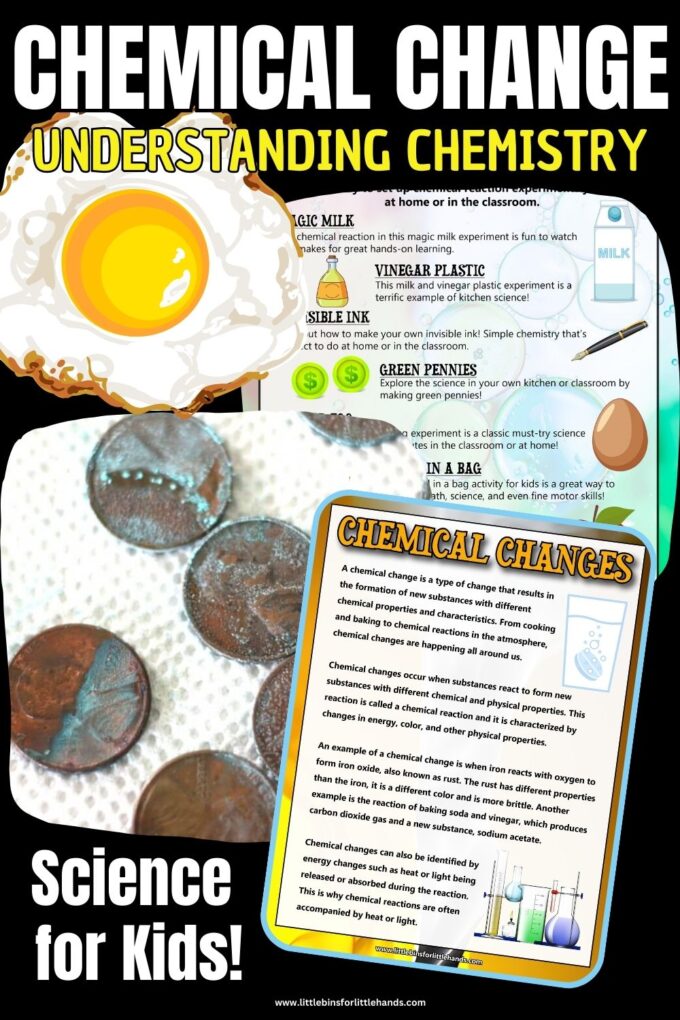
Chemistry For Kids
Let’s keep it basic for our junior scientists. Chemistry is all about how different materials are put together and what they are made up of, like atoms and molecules… Like all sciences, chemistry is about solving problems and figuring out why things do what they do. Kids are great for questioning everything!
Our chemistry experiments will teach you about chemical reactions, acids and bases, solutions, crystals, and more! All with easy household supplies!
Encourage your kids to make predictions, discuss observations, and re-test their ideas if they don’t get the desired results the first time. Science always includes an element of mystery that kids naturally love to figure out! Learn more about the scientific method for kids.
Learn about what it means for a substance to undergo a chemical change with one of these hands-on experiments below and our simple chemical change definition for kids.
What Is A Chemical Change?
Chemical Change Definition: A chemical change is a change that results in the formation of new substances with different chemical properties and characteristics. From cooking and baking to chemical reactions in the atmosphere, chemical changes are happening everywhere.
Chemical changes occur when substances react to form new substances with different chemical and physical properties to the original substances. This reaction is called a chemical reaction and it is characterized by changes in energy, color, and other physical properties.
One example of a chemical change is when iron reacts with oxygen to form iron oxide, also known as rust. The rust has different properties than the iron, it is a different color and is more brittle.
Another example of a chemical change is the reaction of baking soda and vinegar, which produces carbon dioxide gas and a new substance, sodium acetate.
Chemical changes can also be identified by energy changes, such as heat or light being released or absorbed during the reaction. This is why chemical reactions are often accompanied by heat or light.
Chemical vs Physical Change
What is the difference between a physical change and a chemical change? A physical change can be identified by a change in shape or form, however, it doesn’t undergo a chemical process to become a new substance. Learn more about physical changes here.
Often physical changes are reversible; think of ice melting to form a liquid and then frozen again to form solid ice, as in our Solid, Liquid, Gas experiment. Chemical changes are irreversible, therefore, they cannot be easily undone.
Typically you can tell that a chemical change has occurred by looking for one or more of these indicators…
- Color change
- Change in appearance
- Odor produced
- Gas produced
- Heat produced
- Heat absorbed
- Light emitted
Is boiling water a chemical change?
When you boil water, the liquid water molecules change to gaseous water molecules, and evaporate into the air. Can this change be easily reversed? Has a new substance formed? Well no! Gaseous water is the same as liquid water, it is simply a different state of matter. If you were to place a lid on top of the boiling water, you would see the gas condense back into liquid.
Is frying an egg a chemical change?
Cooking an egg for breakfast, that runny egg white and yolk change to a solid egg. You will notice the clear egg white also changes to a white color. The heat from frying the egg has caused a chemical change to occur. It changes the structure of the egg’s protein in a process called denaturing. The change is permanent!
Everyday Examples Of Chemical Changes
Here are 15 everyday examples of chemical changes. Can you think of any more?
- Burning wood
- Baking a cake
- Frying a steak
- Boiling an egg
- Burning a candle
- Lighting a match
- Rusting nails
- Washing hands with soap
- Fermentation
- Souring milk
- Photosynthesis
- Digesting food
- Banana rotting
- Chemical batteries
- Running a lawn mower
FREE Chemical Change Info pack to get started!
Share examples of chemical changes and the fun science behind them with this free printable chemical changes guide.
Chemical Change Experiments
Here are some fun examples of chemical changes in experiments that use everyday household items. What could be easier? Think baking soda, vinegar, hydrogen peroxide, lemon juice, Alka Seltzer tablets, and more!
Alka Seltzer Rocket
Use the chemical reaction that happens when you add an Alka Seltzer tablet to water to make this cool DIY Alka Seltzer rocket.
Apple Browning Experiment
Why do apples turn brown? It is all to do with a chemical change when the cut part of the apple reacts with air.
Balloon Experiment
Use a classic baking soda and vinegar reaction to inflate a balloon.
Bath Bombs
Make homemade bath bombs for a fun chemical change in your bath. Try our Christmas bath bomb recipe, LEGO bath bombs or make Halloween bath bombs. The base ingredients are the same, citric acid and baking soda.
Baking Powder Science
Find out what happens to baking powder when you add water. Here is a simple chemical reaction that you use in baking.
Bottle Rocket
Turn a simple water bottle into a DIY water bottle rocket using a baking soda and vinegar chemical reaction.
Bread In A Bag
A fun chemical reaction you can eat! The chemical change is in the dough, notice what it looks like raw and then cooked. Follow our bread in a bag recipe for a fun treat the kids are sure to enjoy!
Citric Acid Experiment
Grab some oranges, lemons, and baking soda to experiment with citric chemical reactions! Or just check out this lemon volcano.
Cranberry Experiment
What happens when you add baking soda to cranberry and lemon juice? Lots of fizzing action, of course!
Egg In Vinegar
Can you make a naked egg? Observe how a chemical reaction between calcium carbonate (eggshell) and vinegar makes for a bouncy egg.
Elephant Toothpaste
Kids of all ages will love this exothermic chemical reaction using hydrogen peroxide and yeast. Not only does it produce a lot of froth when the ingredients combine together. Hence the name! The reaction also produces heat.
Green Pennies
Explore how the patina of pennies forms from a chemical reaction. Try this fun penny experiment!

Invisible Ink
Write a message that no one else can see until the ink is revealed. Find out how to make your own invisible ink that is revealed with a simple chemical reaction.
Lava Lamp Experiment
This oil and water experiment does involve a bit of physics but it also includes a fun Alka Seltzer reaction!
Milk And Vinegar
Kids will be amazed by the transformation of a couple of common household ingredients, milk and vinegar, into a moldable, durable piece of a plastic-like substance.
Popping Bags
You will want to take this fun experiment outside! Try bursting bags with only a baking soda and vinegar reaction.
Slime
Making slime has to be one of the most fun examples of a chemical change. Watch how 2 ingredients, glue and saline solution (slime activator) becomes an amazing goopy, stretchy, slimy substance.
Volcano
Make a homemade volcano project with salt dough and baking soda and vinegar reaction. Of course, there is so many more ways to have fun with baking soda and vinegar volcano.
More Helpful Science Resources
Here are a few resources to help you introduce science more effectively to your kiddos or students and feel confident when presenting materials. You’ll find helpful free printables throughout.
- Best Science Practices (as it relates to the scientific method)
- Science Vocab
- 8 Science Books for Kids
- What Is A Scientist
- Science Supplies List
- Science Tools for Kids
Science Experiments By Age Group
We’ve put together a few separate resources for different age groups, but remember that many experiments will cross over and can be re-tried at several different age levels. Younger kiddos can enjoy the simplicity and hands-on fun. At the same time, you can talk back and forth about what is happening.
As kiddos get older, they can bring more complexity to the experiments, including using the scientific method, developing hypotheses, exploring variables, creating different tests, and writing conclusions from analyzing data.
- Science for Toddlers
- Science for Preschoolers
- Science for Kindergarten
- Science for Early Elementary Grades
- Science for 3rd Grade
- Science for Middle School
Printable Science Projects For Kids
If you’re looking to grab all of our printable science projects in one convenient place plus exclusive worksheets and bonuses like a STEAM Project pack, our Science Project Pack is what you need! Over 300+ Pages!
- 90+ classic science activities with journal pages, supply lists, set up and process, and science information. NEW! Activity-specific observation pages!
- Best science practices posters and our original science method process folders for extra alternatives!
- Be a Collector activities pack introduces kids to the world of making collections through the eyes of a scientist. What will they collect first?
- Know the Words Science vocabulary pack includes flashcards, crosswords, and word searches that illuminate keywords in the experiments!
- My science journal writing prompts explore what it means to be a scientist!!
- Bonus STEAM Project Pack: Art meets science with doable projects!
- Bonus Quick Grab Packs for Biology, Earth Science, Chemistry, and Physics


